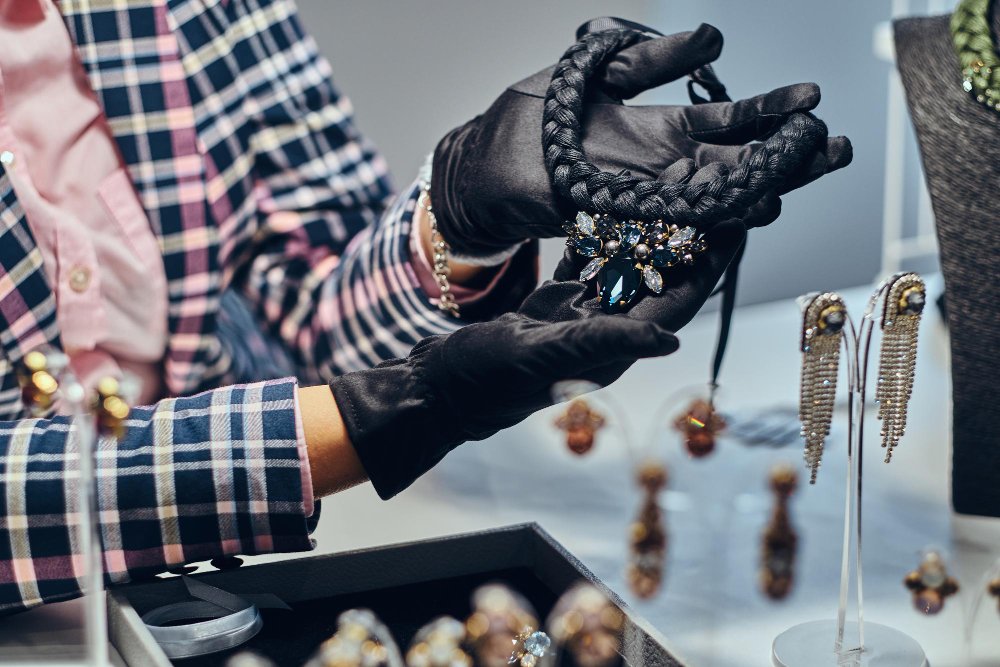
Are you passionate about jewelry and dreaming of starting your own business in the industry? From dazzling gemstones to unique designs, the world of jewelry offers endless opportunities for entrepreneurial success. But before embarking on this exciting journey, it’s essential to understand the costs involved and the steps required to establish a thriving jewelry business.
Whether you want to dive into jewelry making, design your own pieces, or curate a collection of exquisite accessories, this comprehensive guide will provide you with all the necessary insights and strategies to kickstart your venture. From calculating startup costs to defining your brand identity and marketing your products, we’ll cover every aspect of starting a jewelry business.
Key Takeaways:
- Understanding the costs involved in starting a jewelry business is crucial for effective planning and budgeting.
- Creating a solid business plan is essential for outlining your goals, target market, and growth strategies.
- Conducting thorough market research helps identify trends, competitors, and opportunities in the jewelry industry.
- Calculating startup costs involves considering expenses such as equipment, materials, inventory, and marketing.
- Exploring various funding options can help secure the necessary capital to launch and grow your jewelry business.
Are you ready to turn your passion for jewelry into a profitable business? Let’s dive into the world of starting a jewelry business!
Creating a Jewelry Business Plan
When starting a jewelry business, it’s essential to have a solid plan in place to guide you through the process and ensure your success. A well-crafted jewelry business plan will outline your goals, strategies, and financial projections, providing you with a roadmap for building and growing your venture.
An effective jewelry business plan should include the following key elements:
- Executive Summary: Provide an overview of your business, including your mission statement, target market, and competitive advantage.
- Market Analysis: Conduct thorough market research to identify trends, customer preferences, and competitor analysis. This will help you position your jewelry business strategically.
- Product Line: Describe the types of jewelry you plan to offer, including materials, styles, and price points. Showcase your unique selling proposition and any potential product differentiators.
- Sales and Marketing Strategy: Outline your marketing and sales tactics, including online and offline channels, social media presence, and promotional activities.
- Operations and Management: Detail your business structure, organizational chart, and personnel requirements. Identify any suppliers or manufacturers you’ll partner with for sourcing materials and production.
- Financial Projections: Include a comprehensive financial forecast, including income statements, balance sheets, and cash flow projections. This will help you assess the viability and profitability of your jewelry business.
- Risk Analysis: Identify potential risks and challenges that may impact your business, such as economic fluctuations, industry trends, or supply chain disruptions.
Setting up a jewelry business requires careful planning and attention to detail. Follow these tips to effectively create your jewelry business plan:
- Research and Analysis: Take the time to conduct thorough market research and analyze industry trends. This will help you identify market gaps and opportunities for growth.
- Set Clear Goals: Define your business objectives and set realistic, measurable goals. This will provide you with a benchmark for tracking your progress and making adjustments as needed.
- Seek Feedback: Share your business plan with trusted advisors, mentors, and industry experts. Their input can provide valuable insights and help you refine your strategies.
- Regularly Review and Update: Your jewelry business plan should not be static. Regularly review and update your plan to reflect changes in the market, industry, or your own business goals.
Remember, a well-developed jewelry business plan serves as a roadmap to success. It helps you stay focused, set achievable goals, and navigate the complexities of the jewelry industry.
| Benefits of a Jewelry Business Plan | |
|---|---|
| 1. Provides clear direction for your business | |
| 2. Allows you to make informed decisions | |
| 3. Helps secure funding from investors or lenders | |
| 4. Sets realistic goals and benchmarks | |
| 5. Assists in identifying potential risks and challenges |
Conducting Market Research
Market research plays a crucial role in the success of your jewelry business. By gathering key insights about your target market and competitors, you can make informed decisions and refine your business strategies. In this section, we’ll explore the importance of market research in the jewelry industry and provide jewelry business ideas and tips to help you get started.
Free Ebook: Conquer Your Finances!
Our free ebook, “Youth Finance: A Beginner’s Guide to Financial Literacy” is your guide!
Inside, you’ll learn
Identifying Your Target Market
To effectively market your jewelry products, it’s essential to identify your target market — the specific group of individuals who are most likely to purchase your jewelry. Consider factors such as age, gender, location, and income level. By understanding your target market’s preferences and needs, you can tailor your products and marketing efforts accordingly.
Analyzing Competitors
Carrying out a competitor analysis is vital to gain a competitive edge in the jewelry industry. Identify your main competitors — both local and online — and analyze their products, pricing strategies, marketing tactics, and target markets. This analysis will help you identify gaps in the market and opportunities for differentiation.
Quote: “It’s not enough to be unique in the jewelry business; you need to be better. By researching and analyzing your competitors, you can gain insights into their strengths and weaknesses, and use that knowledge to position your jewelry business for success.” – Jane Edwards, Jewelry Business Consultant
Gathering Insights and Refining Strategies
Market research allows you to gather valuable insights that can inform your business decisions and strategies. By conducting surveys, focus groups, or analyzing customer feedback, you can gain a deeper understanding of what your target market wants and needs.
Use these insights to refine your product offerings, pricing, marketing campaigns, and overall business strategy. Regularly monitor market trends and consumer preferences to stay ahead of the curve and adapt your business accordingly.
Table: Jewelry Market Research Checklist
| Research Area | Key Components to Consider |
|---|---|
| Target Market Analysis | Analyze demographics, psychographics, buying behaviors, and preferences of your target market. |
| Competitor Analysis | Identify and analyze your main competitors, focusing on their products, pricing, marketing strategies, and unique selling points. |
| Trends and Opportunities | Stay updated with the latest jewelry trends and identify potential gaps or opportunities in the market. |
| Customer Feedback | Gather feedback from your customers through surveys, focus groups, or online reviews to understand their satisfaction levels and areas for improvement. |
By conducting comprehensive market research, you can gain valuable insights into your target market, competitors, and industry trends. This knowledge will empower you to make informed decisions and implement effective strategies to grow your jewelry business.
Calculating Startup Costs
Starting a jewelry business requires careful financial planning to ensure a solid foundation for success. Understanding the various expenses involved in setting up your venture is crucial for estimating your startup costs accurately. Here, we will break down the different components that contribute to the overall cost of starting a jewelry business.
1. Equipment and Tools
Investing in the right equipment and tools is essential for producing high-quality jewelry. From bench tools and soldering equipment to polishing machines and gemstone setting tools, it’s important to budget for these necessary items. Research reputable suppliers to find tools that strike a balance between quality and cost-effectiveness.
2. Materials and Inventory
Acquiring materials and building inventory is a significant expense for a jewelry business. This includes precious metals like gold and silver, gemstones, beads, findings, and packaging materials. Estimating the quantity and cost of materials you need to create your designs is crucial for accurate budgeting.
3. Workspace and Utilities
Consider the space you’ll need to set up your jewelry workshop or studio. This could be a rented space or a dedicated area in your home. Factor in rent, utilities, and any renovations or modifications required to create a functional workspace.
4. Marketing and Branding
Your marketing and branding efforts are essential for attracting customers and standing out in the competitive jewelry market. Budget for a professionally designed logo, website development, online marketing campaigns, print collateral, and social media advertising. Additionally, allocate funds for attending trade shows and craft fairs to showcase your jewelry and build brand awareness.
5. Legal and Administrative Costs
Starting a business involves legal and administrative expenses. This includes business registration and licensing fees, permits, trademark registration if applicable, and professional services such as accounting and legal advice. It’s important to consult with experts in these areas to ensure compliance with local regulations.
6. Packaging and Shipping
Consider the cost of packaging materials, including boxes, bags, ribbons, and labels, as well as shipping supplies such as bubble wrap, tape, and shipping labels. Proper packaging not only protects your jewelry but also enhances the perceived value of your brand.
7. Contingency Fund
It’s always wise to allocate a portion of your budget for unforeseen expenses or emergencies. This contingency fund will provide a safety net and allow you to handle unexpected costs without jeopardizing your business.
By considering these various startup costs, you can create a comprehensive budget that aligns with your business goals and aspirations. Remember, accurate financial planning is crucial for setting realistic expectations and ensuring the long-term success of your jewelry business.
Securing Funding for Your Jewelry Business
Starting an online jewelry business can be an exciting endeavor, but it requires careful financial planning. In this section, we will explore different financing options available to support your jewelry business startup. Whether you’re looking for funds to purchase inventory, invest in marketing, or cover other startup costs, understanding your financing options is crucial.
Self-Funding
One of the first financing options to consider is self-funding. This involves using your own personal savings or assets to finance your jewelry business. Self-funding gives you complete control over your business finances and eliminates the need to pay interest or give up equity. However, it’s important to assess your own financial situation and determine if you have enough capital to cover the startup costs.
Loans
Another common financing option is taking out a loan. Traditional lenders, such as banks or credit unions, offer business loans that can be used to fund your jewelry business. Before applying for a loan, prepare a solid business plan and financial projections to demonstrate your ability to repay the loan. Keep in mind that loans typically require collateral or a good credit history.
Crowdfunding
Crowdfunding has gained popularity as a way to raise funds for various businesses, including jewelry startups. Platforms like Kickstarter or Indiegogo allow you to showcase your jewelry designs to a wide audience and seek financial support. In return, backers may receive early access to your products or exclusive rewards. Crowdfunding can not only provide the necessary funds but also help you validate the demand for your jewelry.
Investment
If you’re looking for a larger investment to scale your jewelry business quickly, seeking investors might be an option. You can approach angel investors or venture capitalists who are interested in the jewelry industry. Be prepared to present a compelling business plan, market analysis, and growth potential to attract potential investors. Keep in mind that giving up equity means sharing your business profits and decision-making power.
When securing funding for your jewelry business, it’s important to carefully evaluate each option and choose the one that aligns with your long-term goals and financial capabilities. Whichever route you decide to take, make sure to have a solid plan in place and be prepared for the challenges that come with starting and growing a successful online jewelry business.
Setting Up Your Workspaces and Equipment
When starting a jewelry business, it’s essential to set up your workspaces and equipment properly. Whether you have a dedicated studio or are working from home, having a well-organized and equipped space will contribute to your productivity and creativity. In this section, we’ll explore the essential equipment and tools you’ll need to start making jewelry at home.
Setting Up Your Jewelry Workspace
Your jewelry workspace is where your creative ideas come to life. It should be a clean, well-lit, and organized area that inspires you to work efficiently. Here are some key factors to consider when setting up your jewelry design space:
- Choose a well-ventilated area with ample natural light or invest in proper lighting equipment.
- Ensure your workspace has sufficient storage to keep your tools, materials, and supplies organized and easily accessible.
- Invest in a comfortable chair and ergonomic worktable to prevent strain and promote good posture.
- Create a dedicated space for soldering, polishing, and other specialized tasks to minimize the risk of accidents.
- If working from home, consider separating your jewelry workspace from other household activities to minimize distractions.
Essential Jewelry Making Equipment
Equipping your workspace with the right tools and equipment is crucial for producing high-quality jewelry pieces. Here are some essential items you’ll need:
| Equipment | Description |
|---|---|
| Jeweler’s Bench | A sturdy workbench designed specifically for jewelry making, providing a stable surface for tasks. |
| Jeweler’s Saw | A small, handheld saw used for precision cutting of metal sheets and wires. |
| Files and Sandpapers | Used for smoothing, shaping, and refining metal surfaces. |
| Jeweler’s Torch | A torch for soldering, annealing, and manipulating metal components. |
| Pliers and Cutters | Assorted pliers and cutters for bending, shaping, and cutting wire or chain. |
| Hammer and Anvil | Used for forging and shaping metal by hammering it on an anvil’s surface. |
| Bench Pin | A small wooden support attached to the workbench, used for sawing and filing. |
| Jeweler’s Loupe | A magnification tool to examine details and work with precision. |
| Safety Equipment | Protective goggles, gloves, and aprons to ensure safety while working with hazardous materials. |
Having these essential tools and equipment will allow you to work with precision and achieve professional-quality results. Remember to invest in high-quality tools that will last and perform well over time.
“A well-organized and equipped jewelry workspace is the foundation of a successful jewelry business. It not only enhances your productivity but also creates a space where your creativity can thrive.”
By setting up your workspaces and acquiring the necessary equipment, you’ll be one step closer to realizing your dream of starting a successful jewelry business. Take the time to plan and create a space that inspires you and supports your creative process.
Sourcing Quality Materials and Supplies
When starting a jewelry business, one of the key factors that determines the quality and appeal of your products is the materials and supplies you use. Finding reliable sources for high-quality materials is essential for creating beautiful and long-lasting jewelry pieces. In this section, we’ll explore different avenues for sourcing the materials and supplies needed to bring your jewelry designs to life.
Considerations for Material Sourcing
When choosing where to source your materials, there are several factors to consider:
- Cost: Finding cost-effective options that align with your budget is crucial, especially when you’re just starting your jewelry business.
- Reliability: Working with reliable suppliers ensures that you have a consistent and steady supply of materials.
- Sustainability: With increasing consumer demand for sustainable and ethically sourced products, choosing suppliers who prioritize sustainability can give your business a competitive edge.
Types of Suppliers
Here are some common types of suppliers you can explore for your jewelry business:
| Supplier Type | Pros | Cons |
|---|---|---|
| Wholesalers | – Offer a wide selection of materials at discounted prices – Convenient for bulk purchases |
– May have minimum order quantities – Limited customization options |
| Craft Stores | – Provide a variety of materials for DIY jewelry making – Easily accessible |
– Prices may be higher compared to wholesale suppliers – Limited specialty materials available |
| Online Marketplaces | – Offer a vast range of materials from different suppliers – Easy price comparison |
– Potential for counterfeit or poor-quality products – Longer shipping times |
| Direct from Manufacturers | – Access to specialized and unique materials – Possibility for custom orders and designs |
– Minimum quantity requirements – Higher prices for exclusive materials |
It’s important to do thorough research and consider your specific business needs when choosing suppliers. Evaluating the quality, pricing, and reputation of potential suppliers will help you make informed decisions that align with your goals and values.
Building Relationships with Suppliers
Developing strong relationships with your suppliers is beneficial for your jewelry business in the long run. Here are some tips for fostering good relationships:
“Building strong relationships with your suppliers is not just about getting the best prices; it’s about establishing trust, open communication, and mutual respect. When both parties are invested in each other’s success, it creates a win-win situation.”
- Communicate clearly and effectively with your suppliers to ensure smooth transactions and timely deliveries.
- Consider negotiating for better prices or discounts when purchasing in bulk or establishing a long-term partnership.
- Stay informed about industry trends and changes to anticipate any potential disruptions in the supply chain.
By sourcing high-quality materials and supplies for your jewelry business, you can ensure the integrity and appeal of your products. Taking the time to find reliable suppliers that align with your budget and sustainability goals will set you up for success in the competitive world of jewelry making.
Establishing a Strong Brand Identity
In today’s competitive jewelry industry, it’s essential to establish a strong brand identity to differentiate your business from the rest. A compelling brand story, logo, and visual elements can help you create a lasting impression on your target market and build a loyal customer base.
“A strong brand identity is the foundation of a successful jewelry business.”
When creating your brand story, think about what sets your jewelry business apart. What is your unique selling proposition? Consider the inspiration behind your designs, the craftsmanship, or the materials you use. Your brand story should resonate with your target market and evoke emotions that align with your jewelry’s aesthetic.
Once you have defined your brand story, it’s time to design a compelling logo that reflects your business’s essence. Your logo will be the face of your jewelry brand and will appear across various touchpoints, from your website to packaging. Ensure that your logo is visually appealing, memorable, and aligns with your brand story.
Alongside your brand story and logo, pay close attention to the visual elements that represent your jewelry business. This includes color schemes, typography, and imagery. Consistency across these elements helps reinforce your brand identity and enhances brand recognition.
Table: Elements of a Strong Brand Identity
| Brand Element | Description |
|---|---|
| Brand Story | A narrative that encapsulates your jewelry business’s uniqueness and values. |
| Logo | A visual representation of your brand that appears on your website, products, and marketing materials. |
| Color Schemes | A cohesive set of colors that creates a visually appealing and consistent brand identity. |
| Typography | The style of fonts used in your brand’s communication, reflecting your brand’s personality. |
| Imagery | The visuals used to represent your brand, including product photography and lifestyle images. |
By carefully crafting your brand identity, you can make a strong impression on your target market, earn their trust, and establish a distinct presence in the jewelry industry.
Marketing and Promoting Your Jewelry Business
Once you have established your jewelry business, it is crucial to implement effective marketing strategies to reach your target audience and drive sales. To help you navigate the world of jewelry business promotion, we have compiled a list of key tips and ideas to maximize your marketing efforts.
Want YouTube success, but camera shy?
Tube Mastery 3.0 teaches you to build profitable channels WITHOUT showing your face! ✅ Niche selection, video creation (no camera!), growth strategies & more. See student results: 40,000 subscribers in 5 months & $4,000 daily income! Learn the faceless YouTube method & ditch the camera! ➡️ [Link here]
Social Media Marketing
Social media platforms offer an excellent opportunity to showcase your jewelry designs and connect with potential customers. Create engaging posts featuring high-quality images of your products, and leverage popular platforms such as Instagram, Facebook, and Pinterest to reach a wider audience.
“Social media marketing allows you to directly engage with your audience, build brand awareness, and generate leads for your jewelry business.” – Jane Smith, Social Media Marketing Expert
Website Development
Having a professional and user-friendly website is essential in the digital age. Your website should showcase your jewelry collection, provide detailed product descriptions, offer a seamless shopping experience, and include an easy-to-use checkout process. Optimize your website for search engines to increase visibility and organic traffic.
Content Creation
Create compelling and informative content that resonates with your target audience. This can include blog posts, tutorials, videos, or even behind-the-scenes glimpses into your jewelry-making process. By consistently producing valuable content, you can establish yourself as an authority in the industry and attract potential customers.
Promotional Activities
Consider participating in jewelry trade shows, local events, or collaborating with influencers in the fashion and jewelry industry. These opportunities can help you increase brand awareness, expand your network, and build valuable partnerships.
Customer Engagement
Engage with your customers through personalized emails, newsletters, and loyalty programs. Offer special promotions, discounts, or exclusive giveaways to encourage repeat purchases and foster customer loyalty.
Marketing and Promoting Your Jewelry Business Strategies
| Strategy | Description |
|---|---|
| Social Media Marketing | Utilize popular social media platforms to showcase your jewelry designs and engage with your target audience. |
| Website Development | Create an appealing and user-friendly website to showcase your products and offer a seamless shopping experience. |
| Content Creation | Produce valuable and engaging content such as blog posts, tutorials, and videos to attract and educate your target audience. |
| Promotional Activities | Participate in trade shows, local events, and collaborate with influencers to increase brand visibility and build partnerships. |
| Customer Engagement | Interact with your customers through personalized emails, newsletters, and loyalty programs to foster loyalty and encourage repeat purchases. |
Implementing these marketing strategies will help you position your jewelry business for success and stand out in a competitive market. By effectively reaching and engaging your target audience, you can build a strong brand presence, increase sales, and establish long-lasting customer relationships.
Conclusion
In conclusion, starting a jewelry business requires careful planning, market research, and strategic decision-making. By following the essential steps outlined in this article and considering the associated costs, you can set yourself up for success in the competitive jewelry industry.
Creating a comprehensive business plan, conducting thorough market research, and calculating startup costs are vital aspects when starting a jewelry business. These steps will help you identify your target market, understand your competition, and estimate the necessary funding required for a successful launch.
Additionally, setting up well-equipped workspaces, sourcing quality materials, establishing a strong brand identity, and implementing effective marketing strategies are all crucial in positioning your jewelry business for growth and profitability in the market.
Keep in mind that the success of your jewelry business will also depend on your passion, creativity, and dedication to delivering high-quality jewelry pieces that resonate with your target audience. With the right approach and consistent effort, you can turn your passion for jewelry into a thriving and lucrative business.
FAQ
What are the costs involved in starting a jewelry business?
The costs of starting a jewelry business can vary depending on factors such as the scale of your operation, location, and the type of jewelry you plan to create. Typical startup costs include expenses for equipment, materials, inventory, marketing, and legal fees. It’s essential to create a detailed budget to estimate and plan for these costs before launching your business.
How important is it to create a jewelry business plan?
Creating a comprehensive business plan is crucial for the success of your jewelry business. It serves as a roadmap, outlining your goals, target market, marketing strategies, financial projections, and more. A well-designed plan can help you secure funding, make informed business decisions, and stay on track as you navigate the challenges of the industry.
How can market research help in establishing a jewelry business?
Market research plays a vital role in understanding your target market, evaluating competitors, and identifying trends in the jewelry industry. It helps you uncover valuable insights that can shape your product offerings, marketing strategies, and pricing decisions. By conducting thorough market research, you can position your jewelry business for success and meet the needs and preferences of your customers.
What are the typical startup costs for a jewelry business?
Startup costs for a jewelry business can vary widely depending on factors such as the type of jewelry you create and your business model. Costs may include equipment (such as tools, machinery, and jewelry-making supplies), materials (gemstones, precious metals, etc.), packaging, branding, website development, marketing, legal fees, and initial inventory. It’s essential to conduct a thorough cost analysis when estimating your startup expenses.
How can I secure funding for my jewelry business?
There are various options for securing funding for your jewelry business. You can consider self-funding by using your savings, seeking loans from financial institutions, exploring government grants and assistance programs, or crowdfunding platforms. Additionally, some entrepreneurs choose to attract investors who are interested in supporting jewelry startups. Each option has its advantages and considerations, so it’s crucial to thoroughly assess your financial needs and explore the different avenues available.
How do I set up my jewelry workspaces and equipment?
Setting up your jewelry workspaces will depend on the scale and type of jewelry business you plan to establish. Whether it’s a dedicated studio or a home-based setup, you’ll need essential equipment such as workbenches, specialized hand tools, soldering equipment, polishing machines, and storage solutions. Consider factors like safety, organization, and efficiency when designing your workspace to ensure a productive and comfortable environment.
Where can I find high-quality materials and supplies for my jewelry business?
When sourcing materials and supplies for your jewelry business, consider reputable suppliers, both local and online. Attend trade shows and exhibitions in the jewelry industry to connect with suppliers directly. You can also join jewelry-making communities or networks to gain insights and recommendations from experienced artisans. Quality materials and supplies are crucial for producing exceptional jewelry pieces and maintaining a good reputation in the industry.
How important is establishing a strong brand identity for a jewelry business?
Establishing a strong brand identity is essential for standing out in the competitive jewelry industry. Your brand identity encompasses your brand story, logo, visual elements, and overall perception in the market. A well-defined brand identity helps create an emotional connection with your target market, establishes credibility, and sets you apart from competitors. It’s a way to communicate the essence of your jewelry business and build a loyal customer base.
What are some effective strategies for marketing and promoting a jewelry business?
To market and promote your jewelry business successfully, consider a multi-faceted approach. Create a visually appealing and user-friendly website to showcase your jewelry collections. Utilize social media platforms to engage with your audience, share captivating content, and build a community. Collaborate with influencers or bloggers in the jewelry niche, participate in trade shows or craft fairs, and consider online advertising or email marketing campaigns. Tailor your marketing strategies to your target market and consistently monitor their effectiveness.
In conclusion, what are the essential steps to start a jewelry business?
Starting a jewelry business requires careful planning, market research, and strategic decision-making. The essential steps include creating a detailed business plan, estimating startup costs, securing funding, setting up your workspaces and equipment, sourcing high-quality materials, establishing a strong brand identity, and implementing effective marketing strategies. By following these steps, you can set yourself up for success in the competitive jewelry industry.




















